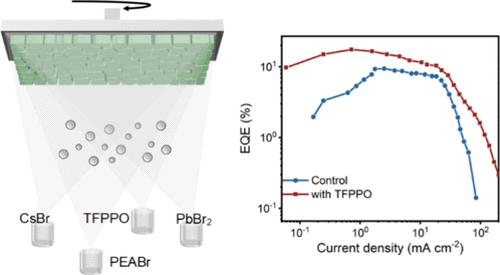Phase Distribution Regulation of Thermally Evaporated Quasi-2D Perovskite Light-Emitting Diodes
IF 18.2
1区 材料科学
Q1 CHEMISTRY, PHYSICAL
引用次数: 0
Abstract
Thermally evaporated quasi-two-dimensional (quasi-2D) perovskite light-emitting diodes (PeLEDs) offer a route toward next-generation display technology. However, their performance has lagged behind solution-processed devices. Here, we introduce an in situ phase regulation strategy by co-evaporating a multifunctional ligand, tris(trifluoromethyl)phosphine oxide (TFPPO). The fluorine atoms in TFPPO form hydrogen bonds with the N–H groups of phenylethylammonium (PEA), suppressing the disordered incorporation of PEA and slowing the crystallization of low-n phases. This interaction promotes a more uniform phase distribution and enhances exciton funneling through energy gradients. Besides, the P═O groups of TFPPO could also passivate undercoordinated Pb2+ defects. As a result, we achieved a record external quantum efficiency (EQE) of 17.5% among thermally evaporated PeLEDs. Furthermore, the optimized emissive layer is seamlessly integrated into a 6.67 in. active-matrix TFT-driven display panel, demonstrating the practical viability of this approach for scalable perovskite display technologies.

热蒸发准二维钙钛矿发光二极管的相位分布规律
热蒸发准二维(准2d)钙钛矿发光二极管(PeLEDs)为下一代显示技术提供了一条途径。然而,它们的性能落后于溶液处理的设备。在这里,我们介绍了一种通过共蒸发多功能配体三(三氟甲基)氧化膦(TFPPO)的原位相位调节策略。TFPPO中的氟原子与苯乙基铵(PEA)的N-H基团形成氢键,抑制了PEA的无序结合,减缓了低n相的结晶。这种相互作用促进了更均匀的相位分布,并增强了激子通过能量梯度的漏斗。此外,TFPPO的P = O基团也可以钝化欠配位Pb2+缺陷。结果,我们在热蒸发等离子体中实现了创纪录的17.5%的外量子效率(EQE)。此外,优化的发射层无缝集成到6.67英寸。有源矩阵tft驱动的显示面板,证明了这种方法在可扩展钙钛矿显示技术中的实际可行性。
本文章由计算机程序翻译,如有差异,请以英文原文为准。
求助全文
约1分钟内获得全文
求助全文
来源期刊

ACS Energy Letters
Energy-Renewable Energy, Sustainability and the Environment
CiteScore
31.20
自引率
5.00%
发文量
469
审稿时长
1 months
期刊介绍:
ACS Energy Letters is a monthly journal that publishes papers reporting new scientific advances in energy research. The journal focuses on topics that are of interest to scientists working in the fundamental and applied sciences. Rapid publication is a central criterion for acceptance, and the journal is known for its quick publication times, with an average of 4-6 weeks from submission to web publication in As Soon As Publishable format.
ACS Energy Letters is ranked as the number one journal in the Web of Science Electrochemistry category. It also ranks within the top 10 journals for Physical Chemistry, Energy & Fuels, and Nanoscience & Nanotechnology.
The journal offers several types of articles, including Letters, Energy Express, Perspectives, Reviews, Editorials, Viewpoints and Energy Focus. Additionally, authors have the option to submit videos that summarize or support the information presented in a Perspective or Review article, which can be highlighted on the journal's website. ACS Energy Letters is abstracted and indexed in Chemical Abstracts Service/SciFinder, EBSCO-summon, PubMed, Web of Science, Scopus and Portico.
 求助内容:
求助内容: 应助结果提醒方式:
应助结果提醒方式:


